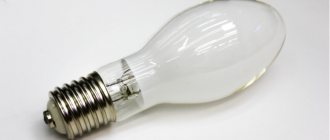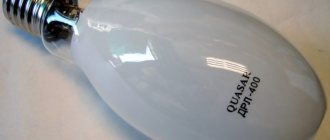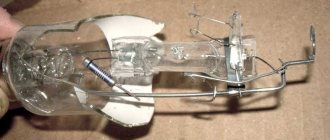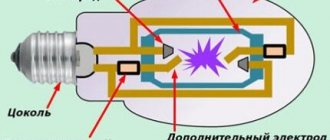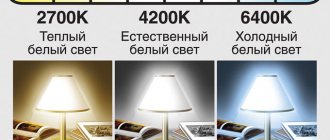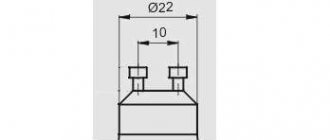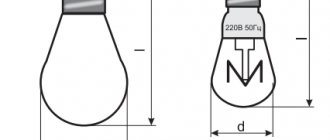Emission spectrum [edit | edit code]
Mercury vapor emits the following spectral lines used in gas-discharge lamps [1] [2] [3]:
| Wavelength, nm | Name | Color |
| 184.9499 | Hard ultraviolet (type C) | |
| 253.6517 | Hard ultraviolet (type C) | |
| 365.0153 | line "I" | Soft UV (Type A) |
| 404.6563 | line "H" | Violet |
| 435.8328 | line "G" | Blue |
| 546.0735 | Green | |
| 578.2 | Yellow-orange |
The most intense lines are 184.9499, 253.6517, 435.8328 nm. The intensity of the remaining lines depends on the discharge mode (parameters).
Advantages and disadvantages
Mercury gas-discharge lamps are an electric light source, one of the types of gas-discharge models. Their work is based on the passage of an electrical discharge through a gaseous medium.
DRL and DRV lamps are gas discharge lamps
Important! To designate light sources of this type, the term “discharge lamp” or RL is used.
Mercury lamps are divided into:
- DRV (interpretation - arc mercury-tungsten);
- DRL (or arc mercury phosphor).
The advantages of direct switching lamps DRV include:
- Ease of connection, use and replacement: they can operate on 220 V AC power and do not require ballasts;
- When warmed up, the resistance increases and stabilizes the network voltage - even at low voltage the light will be stable;
- They can operate from different power sources;
Lamps provide high-quality light
- The light sources are both tungsten filament and fluorescent radiation, that is, cold and warm white colors are mixed. This allows you to get more even light;
- Low price.
The disadvantages are:
- Low luminous efficiency. For example, the efficiency of Philips lamps does not exceed 30 lm/W, although other types of light bulbs from the same company have an output of up to 50 lm/W;
- A small selection of models: in stores there are only 5 models of different power;
- Short service life - no more than 3-4000 hours, and more often less. Replacement is quite expensive, this increases the final cost of the lamps.
Device types
Lamps operating according to the principle described above are of the following types:
FRL – fluorescent mercury arc lamp;
Model HPL-N (Philips)
DRL lamps differ from DRL lamps in that they use a tungsten filament, which performs two functions: a light source and an electric current voltage limiter. To operate a device of this type, no special ballasts are required (throttleless electric lamp);
High pressure DRV devices (HQL), manufacturers Osram and Philips
DRLF – light sources that promote the process of photosynthesis in plants;
DRLF type device
DRUF and DRUFZ - emit in the long-wave ultraviolet spectrum;
Ultraviolet (bactericidal) electric lamp
DRT – tube-type ultraviolet light source;
Lighting source DRT
HPS - tubular lamps, in which, unlike DRL, in addition to mercury, sodium vapor is also used. The main feature is a specific shade of radiation (orange-yellow or golden-white), which requires special equipment to launch.
Mercury-sodium lamp DNAT
Technology development
Technology has also improved. Metal halide lamps are now available. They have added iodine and other metal compounds to improve visible emission and color.
A new variety was created - DRV. This is a hybrid of a classic incandescent lamp and DRL. They have a tungsten filament added to them. It plays the role of a limiting resistor and a radiation source at the same time. The resistor is usually carbon. Here it is made of refractory tungsten. This design solution made it possible to abandon the use of a throttle. This lamp is connected like a regular incandescent lamp - it does not require additional ballasts.
Technical characteristics of DRV and DRL lamps
There are models of various powers on the market: 160 W, 250, 500, and occasionally you can find 700 and 1000 W.
Light bulbs available in different wattages
Below is a technical description for DRV 250 lamps (they are used for artificial lighting in greenhouses):
- Lamp length is 22.5 cm, diameter - 9.1 cm;
- Service life - 3000 hours (on average);
- Luminous flux - 4700 lm;
- Light output level - 18.8 lm/W;
- The voltage is 220 W;
- Nominal power level - 250 W;
- An E40 type base is inserted.
Other models will have different characteristics.
Specifications
We present the main parameters of the DRL and DVR types, as the most common.
The table shows the technical characteristics of DRL lamp models (125, 250, 400 and 700 Watt):
| Type | Power , W) | Starting current (A) | Operating current (A) | Voltage (V) | Luminous flux (lm) | life (h) |
| DRL-125 | 125,0 | 2,40 | 1,15 | 125 | 5900 | 12000 |
| DRL-250 | 250,0 | 4,50 | 2,13 | 130 | 13000 | 12000 |
| DRL-400 | 400,0 | 7,20 | 3,25 | 135 | 23500 | 15000 |
| DRL-700 | 700,0 | 12,00 | 5,40 | 140 | 40600 | 20000 |
Dimensions and type of base:
| Type | Base | Max Length(mm) | Max Diameter(mm) |
| DRL-125 | E27, E40 | 178,00 | 76,00 |
| DRL-250 | E40 | 227,00 | 76,00 |
| DRL-400 | E40 | 250,00 | 91,00 |
| DRL-700 | E40 | 292,00/355,00 | 122,00/152,00 |
Table characterizing the main parameters of DRV devices:
| Type | Base | Operating current (A) | Luminous flux (lm) | Power, W) | Service life (h) |
| DRV-160 | E27,E40 | 0,8 | 2500 | 160 | 4000 |
| DRV-250 | E40 | 1,25 | 4600 | 250 | 4000 |
| DRV-500 | E40 | 2,4 | 12250 | 500 | 4000 |
| DRV-750 | E40 | 3,5 | 22000 | 750 | 4000 |
Economic advantages of mercury lamps
Cost-effectiveness of use is one of the reasons for the great commercial success of tungsten devices, not only in Russia and the CIS countries, but also in developed Western countries. The fact is that strong and powerful incandescent lamps left behind huge umbrella lamps , which, especially in large industries, are extremely expensive to replace in all respects. The costs will be as follows:
- purchasing new lighting fixtures;
- installation of fastening systems;
- installation of lighting lines.
All these expense items can be reduced by installing tungsten light sources in old lamps. These hybrid type light sources are more efficient. It is worth noting that in most cases, purchases of high-pressure mercury lamps are made specifically for DRV devices.
But there are a number of nuances. For example, their light parameters are significantly inferior to even the most inefficient DRL lamps. Why is this happening? Let's find out what the operating principle of DRV lamps is.
Connection
The connection diagram for DRL lamps is shown in the figure; note that the functionality of these lighting sources can only be checked by turning them on accordingly.
Connection diagram for mercury arc light source
Symbols on the diagram:
- EL1 – DRL device;
- C – non-electrolytic type capacitor (must be designed to operate with a voltage of at least 250V), serves to reduce electricity consumption by reducing reactive power;
Video: Connection diagram of the inductor to the DRL lamp
- L1 - throttle;
- F1 – fuse.
Each type of lamp needs a corresponding choke, its task is to reduce the current of the power source, connecting it directly will lead to their failure.
Photo of chokes
The capacitor capacity is selected according to the following table:
| Light source power (W) | Capacitor capacity (uF) |
| 125 | 12,0 |
| 250 | 25,0 |
| 400 | 32,0 |
Chokeless lighting devices (DRL), unlike DRL lamps, do not require a special switching circuit.
Principle of operation
The operating principle of gas-discharge lamps is a little more complicated than that of incandescent light bulbs.
- When current is applied, voltage is transmitted to the current-carrying parts of the base;
- Then the energy passes through the circuit to the electrodes located in the burner, and a glow discharge appears between them. Ions and free electrons begin to accumulate on the surface;
- As ions and electrons accumulate, the internal space of the burner begins to heat up, and the mercury evaporates. The discharge occurs from a glowing state to an arc state, which creates blue or violet radiation;
- This glow causes the phosphor to glow, which creates a reddish light. When all colors are mixed, the result is white.
You can examine the inside of the lamp only by breaking the glass bulb.
The more mercury vapor evaporates, the more the brightness of the discharge increases. On average, it takes 4-5 minutes for the DRL to light up, while the DRL lights up almost immediately.
Important! The higher the air temperature, the less time it will take.
Disposal of mercury lamps
Spent and defective mercury-type lamps belong to the first hazard class waste. They must be disposed of using special equipment. During the processing process, one of four methods can be used:
- amalgamation;
- heat treatment;
- firing at high temperature;
- chemical or metallurgical method.
All disposal methods are aimed at separating and sedimenting mercury vapor, its sublimation, followed by burning of organic components. The final products of processing DRV and DRL lamps without chokes are mercuric chloride and sorbent.
- Author: admin
Rate this article:
- 5
- 4
- 3
- 2
- 1
(0 votes, average: 0 out of 5) Share with your friends!
Marking
In domestic practice, the number following the DRL means power consumption in W. Next comes the red ratio: the ratio of the red flux (from 600 to 780 nm) to the total - expressed as a percentage. The development number is separated by a hyphen. The red ratio characterizes color rendering; values above ten are considered good.
According to the international standard IEC 1231, the ILCOS system is used. These are competitors of the German LBS marking and the pan-European ZVEI. There is complete chaos in the market. According to ILCOS:
- QE stands for ellipsoidal bulb shape.
- QR denotes a bulb with an internal reflective layer, mushroom-shaped.
- QG stands for spherical flask.
- QB stands for products with built-in ballast.
- QBR stands for products with built-in ballast and reflective layer.
Philips has its own view of things, but General Electric doesn’t want to hear about either. Actually, it is better to rely on reference books or read the information on the packaging. Remember that the base comes in standard sizes and in other sizes. The share of DRL lamp production is continuously decreasing, so there is no point in studying complex designations in too much detail. And given the entry of LEDs into the market, it is better to find something modern and constantly evolving for your home and garden. As for efficiency, the dispute will clearly not be resolved in favor of discharge lamps, although for some time they successfully deposited the filament.
DRV and DLR lamp - which is better to choose
DLR stands for "Arc Mercury Fluorescent Lamp". The active luminous element in it is an electric arc that occurs between 2 electrodes and operates in mercury vapor.
The DRV lamp is a mercury tungsten lamp that operates without a choke. It looks like a combination of a DRL burner and a tungsten filament, the latter performing the function of an induction ballast.
On the right is a DRL lamp, on the left is a DRL lamp, the power of both is the same
Despite the similarity of DRL and DVR, there is still a difference between them:
- To ignite a DRL, a ballast is required; for a DRL it is not needed (this is a chokeless bulb);
- The luminous flux of the DRL is 40-50% lower than that of the DRL, but it turns on immediately and does not warm up for several minutes;
- The service life of DRL is longer than that of DVR, since the tungsten filament breaks down quite quickly;
- Many users also note that DRV light bulbs are more energy-consuming.
Advantages and disadvantages of an electromagnetic choke
Now let's talk about the advantages and disadvantages. The advantages of an electromagnetic choke include:
- Relatively low cost.
- Simplicity of design.
- Durability.
Unfortunately, this device has a few more disadvantages. This:
- Large weight and dimensions.
- Flickering of a lamp with double the mains frequency.
- Buzzing.
- Low efficiency due to high inductive reactance.
- At negative voltages, the lamp may not start.
- Long startup (from 1 to 3 seconds).
- During a difficult start-up, the lamp may “blink” for a long time, causing its coils to burn out.
Scope of application
DRV light bulbs are used to illuminate large spaces: streets, open spaces (for example, parking lots), industrial facilities (open and closed).
DRLs are used for lighting:
- Streets and roads;
- Squares, courtyards, squares;
- Warehouses, workshops and other large industrial premises;
- Car parks and gas stations.
Lamps are regularly used to illuminate large spaces
DRV is used in the following places:
- Boulevards, squares, parks and other city blocks;
- At construction sites;
- Warehouses and industrial facilities;
- DRV 25 is used in greenhouses because it produces a redder color.
Application area
This light source was good in its time, but now there are more effective modern solutions. Technically, DVRs can also be used for street lighting, but they are used very rarely in this capacity. But they are still found in park areas, parking lots, and construction sites. This is due to the initial short service life.
More often they can be found indoors. They mainly illuminate production areas of industrial facilities and warehouses.
Thanks to the emission spectrum, DRV-250 can be successfully used for supplementary lighting of plants in greenhouse conditions. This applies only to the DRV-250 model.
Considering the shortcomings of these illuminators and their imminent removal from production, this lighting technology is losing its relevance.
- Related Posts
- Modern office lighting (ideas and recommendations)
- Lamps for the home: varieties, shapes, modern models
- Lamps with e40 base: the most powerful, advantages and disadvantages, circuit diagram of LED lamps
Safety regulations
When using a lamp, you must follow some safety rules:
- Before installing the light bulb, you need to carefully unpack it and make sure there are no mechanical damages;
- It is prohibited to screw in or operate a faulty lamp; you also cannot use an open lamp in an open place where it is not protected from wind or precipitation;
The light bulb must be intact
- After installation, it is necessary to carry out a test by turning on the lamp for 10-15 minutes. After that it can be used. It is important to remember that DRV lamps take several minutes to light up;
Important! If the network voltage is higher than 220 V, the lamps will fail faster and their service life will end earlier.
- Any installation of the lamp must be carried out only with the electricity turned off;
- If the light bulb becomes dirty, wipe it with a dry soft cloth. Solvents or aggressive cleaning agents must not be used;
- The lamp can be placed in any position - both horizontally and vertically;
- Light bulbs should be stored in packaging, not dropped or broken, they should not be given to children or allowed to play with;
- It is necessary to dispose of lamps by handing them over to a collection point for mercury lamps.
Due to mercury vapor, disposal must be carried out at special points
If the light bulb does break, you must:
- Ventilate the room for at least 30 minutes, after leaving it;
- Wear disposable gloves and sweep all large parts into a bag using paper or cardboard;
- Use a wet sponge or tape to collect small pieces. Mercury must be collected moving from the edges to the center;
- At the very end, clean using chlorine.
It is necessary to clean up the mercury spill site with chlorine
DRV and DRL light bulbs are often used to illuminate streets, warehouses, workshops and construction sites. They are easy to install and use, easy to install and change, and provide good quality light. However, both lamps are classified as hazard class 1 due to their mercury content and should be used with caution.
How to start a fluorescent lamp without a throttle
What do DIYers and radio amateurs advise doing in such cases? They recommend using the so-called chokeless circuit for switching on fluorescent lamps.
It uses a diode bridge, capacitors, and ballast resistance. Despite some advantages (the ability to start burnt-out fluorescent lamps), all these schemes are a waste of money for the average user. It is much easier for him to buy a new lamp than to solder and assemble this entire structure.
Therefore, first we will consider another popular method of starting LB or LD lamps with a burnt-out inductor, which will be available to everyone. What do you need for this?
You will need an old burnt out energy saving light bulb with a regular E27 base.
Of course, the circuit using it cannot be considered absolutely chokeless, since the choke is still present on the energy saving board. It’s just much smaller in size, since the housekeeper operates at frequencies of up to several tens of kilohertz.
This mini choke limits the current through the lamp and provides a high voltage pulse for ignition. In fact, this is an electronic ballast in a miniature version.
Previously, there was a large advertising campaign for replacing incandescent lamps with energy-saving ones. Today they are actively being replaced with LED ones.
It is not recommended to throw housekeepers into the trash, just like certain LED models.
Therefore, some conscientious and thrifty citizens who have not yet handed them over to special collection points store such products on their shelves in their lockers.
They change them for a reason. These bulbs, when in working condition, are very harmful to health, both in terms of light pulsation and dangerous ultraviolet radiation.
Although ultraviolet light is not always harmful. And sometimes it brings us a lot of benefit.
At the same time, do not forget that linear luminescent models equally have the same negative factors. They are the ones that actively scare those who like to grow plants under the light of phytolamps.
But let's get back to our energy savings. Most often, their luminous spiral tube stops working (the seal disappears, breaks, etc.).
In this case, the circuit and internal power supply remain intact and unharmed. They can be used in our business.
First you disassemble the light bulb. To do this, along the parting line, use a thin flat screwdriver to open and separate the two halves.
When separating, do not hold the glass tubular flask under any circumstances.
Next, pull out the board. On it, find the places to which the wires from the “filaments” of the bulb are connected. They usually come in the form of pins.
When disassembling, remember which pair is connected where. These pins can be located on one side of the board or on different sides.
In total you should have 4 contacts, where you should solder the wires in the future.
And of course, don’t forget about the 220V power supply. These are the same veins that come from the base.
All that needs to be done next is to solder two conductors to each contact on the board (from the former filaments of the tubes) and lead them to the side pins of the fluorescent lamp.
That is, there are two separate wires on the right and two wires on the left. After that, all that remains is to supply 220V voltage to the energy saving circuit.
The fluorescent light bulb will light up perfectly and work normally. And you don't even need a starter to start it. Everything connects directly.
If the starter is present in the circuit, it will have to be thrown out or bypassed.
LED E-40 to replace DRL-250
Without advertising to certain brands, we can note the most reputable domestic and foreign companies that produce high-quality LED lamps in the E-40 base, which can replace the DRL-250:
E40 BRIGHTLUX IP65 60W – from 7000 rubles, E40 SAMSUNG 60W (Corn) – from 3000 rubles, E40 SDL-KS-60 60W 220V SMD Corn ( Euroled ) – from 4300 rubles, E40 Philips Corn – from 3500 rubles, E40 60w Corn ( Corn) Goled – from 3600 rubles,
conclusions
You can also remember that gas-discharge lamps such as DRL-250 and DRL-400 use mercury. They are harmful in themselves, and a large number of them in production is undesirable. Another weighty argument against mercury lamps is that they will cease to be produced approximately in 2022, then their LED analogues will occupy the lion’s share of the market. Those who say that the luminous flux of mercury lamps is higher than that of LED lamps forget that LED lamps have a higher color temperature. This fact visually neutralizes these differences. Thus, we can conclude that a lower luminous flux cannot be considered a serious disadvantage.
Alternative lighting sources
An energy-saving LED lamp is an excellent analogue to other lighting sources, including DRL; if you buy it, you can significantly save on electricity. Replacing street lighting will pay for itself after three years of operation, even taking into account the refurbishment work.
Many well-known foreign and Russian companies (for example, Lisma) are engaged in the production of these lighting devices. Currently, the price of these devices is slightly higher than the cost of a DRL lamp, but in the near future this problem will be eliminated, which will make LED lighting sources more accessible in Moscow, St. Petersburg, as well as in cities such as Saransk or Yekaterinburg.
DRL lamps detailed description
In fact, DRL lamps are deciphered quite simply:
- D - means that the lighting fixtures are arc.
- R – mercury. Therefore, it is not recommended to use such lamps during home use. After all, if they accidentally break, the harm to the health of all people may be too great.
- L – luminescent.
As you may have noticed, decoding these lamps is quite simple. Now let’s remember the main modifications of DRL. Now the most popular lamps are the following ratings:
The modifications are designated as follows: “DRL” + “number”, which is indicated above. Please note that the number is the lamp power in Watts, so when choosing, pay attention to the second indicator, it is the main one.
And this is what the design of DRL lamps looks like.
Design and operating principle
How a mercury discharge lamp works is shown in the figure.
Description of the symbols presented in the drawing of the design of a DRL type lamp:
- A – nickel-plated base E40 or E27 (the latter only for the DRL 125 model);
- B – resistor for limiting voltage;
- C – foil (made from molybdenum);
- D – additional electrode (igniter);
- E – frame;
- F – glass flask (yttrium vanadate is used to apply the luminomorphic coating);
- G-lead wire;
- H – main electrode (tungsten coated);
- J – nitrogen (used as a filler in the outer flask);
- K – mercury arc lamp;
- L – compressed junction of a quartz lighting source.
Devices of this type can be used in any premises, including fire hazardous ones, if they are installed in explosion-proof luminaires.
